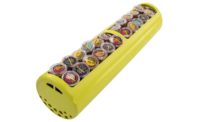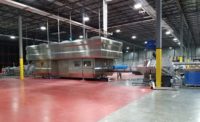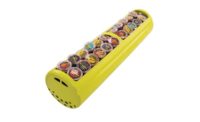The Pressure’s On

Many refrigerated and frozen foods processors find themselves struggling to manage raw materials, formulate with better-for-you recipes and manufacture just-in-time, all while still meeting today’s stringent food safety regulations.
That’s why more and more food producers are incorporating high-pressure pasteurization (HPP).
In May, Quantum Foods, LLC, for instance, installed a USDA- and FDA-approved HPP system for its sliced, diced, cooked, marinated and shredded ready-to-eat meals, deli salads and juice lines in its global distribution center in Bolingbrook, Ill.
|
Typical HPP process:
|
“In a typical HPP process, the product is packaged in a flexible container (usually a pouch or plastic bottle) and is loaded into a high-pressure chamber filled with a pressure-transmitting (hydraulic) fluid. The hydraulic fluid (normally water) in the chamber is pressurized with pumps, and this pressure is transmitted through the package into the food itself. Pressure is applied for a specific time, usually 3-5 minutes,” says Edward Bleka, founder and CEO. “The processed product is removed and stored/distributed in the conventional manner while the water can be recycled. Because the pressure is transmitted uniformly (in all directions simultaneously), food retains its shape even at extreme pressures. Since no heat is needed, the sensory characteristics of the food are retained without compromising microbial safety.”
Stay Fresh Foods, LLC, a start-up based in Meriden, Conn., installed a horizontal 350L-600 system in its new 8,400-square-foot facility. This high-impact system works at a capacity of 350 liters per cycle on products ranging from ready-to-eat meats and deli salads to soups and juices.
Meanwhile, artisan meat processor Daniele Inc., Pascoag, R.I., installed a state-of-the-art HPP machine to extend the shelf life of its meat lines. The 350-liter system uses up to 87,000 pounds per square inch of high-water pressure to inactivate microorganisms, enzymes and pathogens.
This month, American Pasteurization Co. (APC), Milwaukee, opened a facility in Sacramento, Calif., designed to accommodate rising demand for its full-service food testing, pasteurization, packaging and logistics solutions. The 41,000-square-foot plant accommodates up to five HPP production lines, and partners with the National Food Lab to offer customers a complete HPP solution—from testing and validation to implementation of the processing technique.
“HPP is a batch system; throughput hasn’t reached the stage where technology can compete with low-cost, high-speed processes,” says Greg Zaja, president of APC. “As demand grows for safer and longer-lasting natural products, more companies will turn toward HPP.”
One value-added feature from using HPP is shelf-life extension, says Zaja.
“Most products will have the ability to double or in some cases triple their original shelf life,” he says. “Manufacturers can now improve production runs, which lead
|
“Most products will have the ability to double or in some cases triple their original shelf life,” he says. “Manufacturers can now improve production runs, which lead to improved scheduling and reduce the cost of returns. |
to improved scheduling and reduce the cost of returns. Also, they can reduce or eliminate product freezing methods. Not only does this benefit the manufacturers, [but it also] allows the distributor, retailer or foodservice operator to expand distribution areas, reduce out-of-stock items and reduce markdowns due to out-of-date product.”
Food producers can also develop products without having to use preservatives.
“It is highly recommended that all food products have their own challenge studies performed to validate microbial and pathogen reduction,” Zaja adds. “HPP is most effective on food items with high water activity. With validated challenge studies, producers have the ability to eliminate the cost of test and hold. HPP carries significant up-front cost for in-house implementation.”
However, for best results, processors must have large quantities of product processed at once with multiple processing lines.
“Companies such as Hormel Foods have embraced [HPP], and now use this technology to help develop Hormel’s Natural Choice meat product line, which promotes as 100% ‘natural’ with no preservatives,” Zaja says.
Preserving for the future
The future for HPP continues to show growing transformation from a trend that some processors want to one nearly all producers need.
“There is unlimited potential for HPP in the cold food industry because it permits companies to provide the most advanced food safety technology available,” Bleka says. “For now, the market leaders in the protein category are the early adopters.”
The pressure’s on.
Looking for a reprint of this article?
From high-res PDFs to custom plaques, order your copy today!









